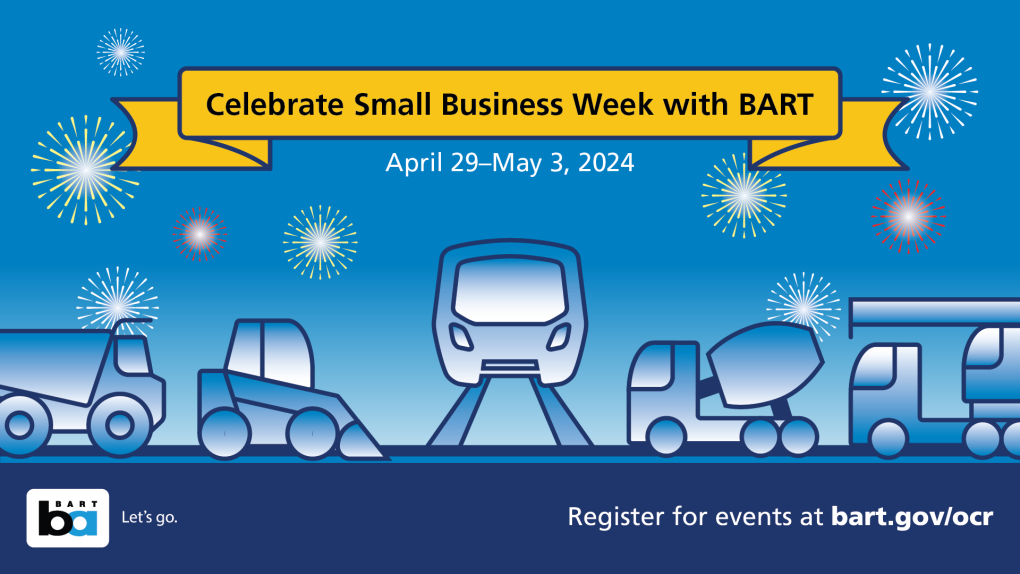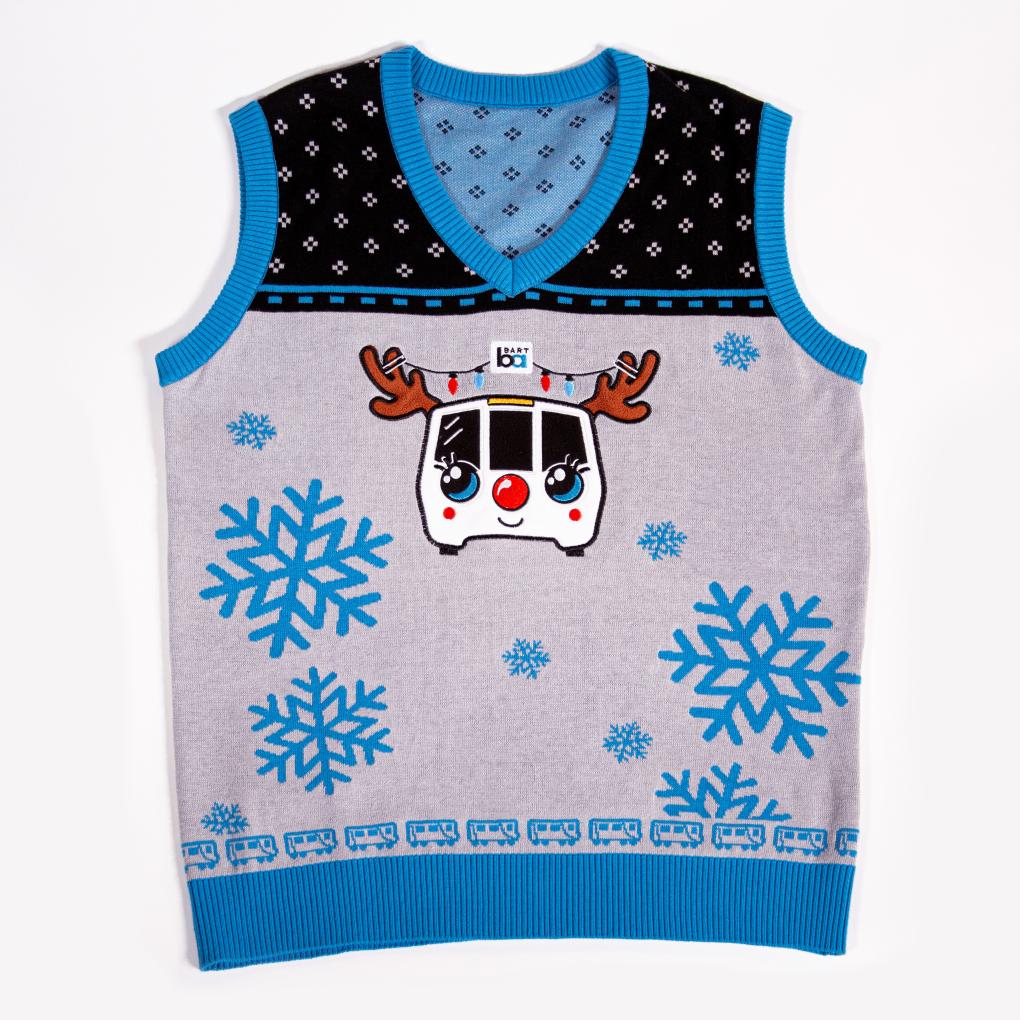Search Results
BART PD’s Progressive Policing Bureau wins prestigious national award for innovation
The BART Police Department’s Progressive Policing and Community Engagement Bureau has won the American Public Transportation Association’s national Innovation Award. The Progressive Policing and Community Engagement Bureau (PPCEB) has established itself as a national model by increasing BART’s safety presence while ensuring the system is welcoming to all members of the community. The PPCEB is a trail blazing part of the effort to ensure BART is the safest way to travel across the Bay Area.
“The members of the Progressive Policing and Community Engagement Bureau are force multipliers for rider safety,” said BART PD interim Chief Kevin Franklin. “The bureau has become a national model with both transit and traditional law enforcement agencies reaching out to us to learn more about the innovative steps we’re taking to boost safety for our riders.”
The numbers show how the PPCEB is boosting rider safety. In the first six months of this year members of the PPCEB performed more than 10,700 welfare checks on people in the BART system who appeared to need help. There were more than 2,500 instances when PPCEB members intervened when they saw violations of BART’s Code of Conduct. In the past those violations would have required a response by a sworn officer. Instead, members of the PPCEB can offer a more appropriate response with unarmed, specially trained BART PD staff. That has freed up sworn officers to respond more quickly to urgent emergency calls. BART PD has one of the fastest response times for tier 1 emergency calls at an average of just more than 4 minutes.
The PPCEB is primarily composed of non-sworn Transit Ambassadors and Crisis Intervention Specialists. These unarmed employees of BART PD receive specialized training in de-escalation techniques. Transit Ambassadors walk dozens of trains and platforms each day. They’re equipped with radios to report safety concerns. They observe, report, and call upon traditional sworn officers when enforcement is needed. Crisis Intervention Specialists have backgrounds in social work and specialize in connecting people at risk with potentially lifesaving services.
The PPCEB was launched in 2020. It was the first of its kind for a transit agency in the U.S. The BART PD model stands out because members of the PPCEB are full-time BART PD employees as opposed to contractors that many other systems rely on. The bureau builds on a history of more than a decade of reform efforts aimed at elevating equitable policing at BART.
BART to Antioch train times to shift beginning March 24, to improve transfer
Beginning Monday, March 24, 2025, BART to Antioch train times will shift by several minutes to improve the connection with BART at the transfer platform in Pittsburg.
We are lengthening the window of time for the regular BART train to connect to the BART to Antioch DMU train to improve the reliability of the transfer. While this will lengthen the total time for trips that include BART to Antioch service, it will significantly cut down on the number of missed transfers, which is currently causing even longer delays for Antioch riders.
This change means departure and arrival times at Antioch and Pittsburg Center stations are shifting by six or seven minutes depending on the direction of travel. We encourage Antioch and Pittsburg Center riders to look up the new train times before the change goes into effect.
Trips from Antioch and Pittsburg Center toward SFO will leave seven minutes earlier than before. Trips from SFO towards Pittsburg Center and Antioch will arrive six minutes later.
For riders who rely on clock-face schedules, here is an example of the change:
- For the current schedule, trips at Antioch Station start on the 10/30/50 minutes after the hour and trips at Pittsburg Center start on the 17/37/57 minutes after the hour.
- For the new schedule, trips at Antioch Station start on the 03/23/43 minutes after the hour (except for the first three trains of the day) and trips at Pittsburg Center start on the 10/30/50 minutes after the hour.
The times for regular BART trains on the Yellow Line (Pittsburg/Bay Point to SFO) are unchanged.
View the Yellow Line PDF timetable for weekday service.
View the Yellow Line PDF timetable for weekend service.
The Trip Planner is in the process of being updated, and riders will be able to see their new itineraries by selecting the date of March 24, 2025, and beyond.
“Making this transfer at Pittsburg work for our riders is very important to us,” said BART Board President Mark Foley, who represents BART to Antioch riders. “It is frustrating to riders when they must wait on the transfer platform with little information. The current schedule has too narrow of a window for the regular BART trains and the BART to Antioch DMU trains to line up. This change will improve the transfer. BART to Antioch riders have some of the longest and most expensive commutes, and I am grateful to the BART team for quickly making changes to prioritize this transfer and East Contra Costa County riders.”
BART will begin to size trains for safety and efficiency starting September 11, 2023
When BART’s reimagined schedule launches September 11, 2023, BART will begin to shorten the length of its least crowded trains to improve safety, allow for a cleaner fleet of cars, and maximize BART’s scarce resources. The adjustment of train lengths is consistent with our top priority of ensuring BART is the safest way to travel around the Bay Area.
Shorter trains mean:
• More police and safety staff presence
• Cleaner trains
• Only new trains will be in service unless there is a need to run an old train
• Fewer delays because new cars have double the reliability rate of old cars and we will have more standby trains available
• $12 million is cost savings
BART will still run long trains during special events.
While BART plans to run shorter trains, we will remain very nimble and monitor crowded data on an hourly basis. Our commitment is to quickly add additional cars to trains if there is a high level of crowding, especially during peak commute hours. While we plan to launch this effort using 8-car and 6-car trains, we will quickly adjust as ridership grows.
Running trains with fewer cars will allow the BART Police Department to increase its visibility on trains and platforms while using the same number of staff. When there’s a call for service, officers can clear shorter trains much more quickly. Officers on train patrols will also be able to walk more of the in-service train cars.
“There is safety in numbers and that’s especially true on BART,” said BART PD interim Chief Kevin Franklin. “This change will allow us to have more eyes on train car as we continue to boost our visible safety presence with our officers and unarmed Transit Ambassadors and Crisis Intervention Specialists. A lot of unwanted behavior will be deterred through the presence of more riders and potential witnesses in every train car.”
Shortening trains allows BART to run only Fleet of the Future trains for its base schedule. Legacy trains will still be used if they are needed during large events or if they are needed to replace a new train, but this move accelerates the retirement of the old fleet.
Sizing trains for safety is a direct response to feedback gathered through the Not One More Girl anti-harassment initiative. Eliminating empty and near-empty trains cars will create a safer, more welcoming environment for women, girls, gender non-conforming people, seniors, families, and all riders. BART encourages people concerned about safety to ride in the first car closest to the Train Operator. These changes have the effect of bringing the first car closer to all riders. Courtesy announcements will be increased about priority seating, removing backpacks, and no bikes on crowded cars.
BART will realize cost savings and efficiency gains through this change. BART is expected to save about $12 million annually through reduced power consumption and cars logging fewer operating hours. It will improve operational flexibility and cleaning crews will have fewer cars to focus on at end of the line stations.
“We want to show the entire region that we’re trying new things with safety in mind,” said Alicia Trost, Chief Communications Officer. “This is a change that will enhance safety and cleanliness while also saving money during our financial crisis without cutting service.”
BART's Safe and Clean plan transforming rider experience at Civic Center Station
BART’s efforts to reimagine the rider experience through an unprecedented commitment to safety and cleanliness appear to be making a difference at a San Francisco station with a history of issues. Recent Passenger Experience Survey (PES) data shows an increase in satisfaction with Civic Center/UN Plaza Station as well as a jump in the percent of respondents who say they feel positively about station cleanliness and safety. Among the findings:
- Satisfaction with the overall BART experience for riders who boarded BART at Civic Center Station increased 9 points from 68% to 77% in the latest quarter (October-December) compared with the previous quarter (July-September).
- Satisfaction with rider safety at Civic Center Station surged by 20 points from the previous quarter from 32 to 52%
- Ratings of concourse cleanliness shot up 18 points from 32% to 50%.
- Ratings of platform cleanliness increased by 17 points from 31% to 48%.
The improvements at Civic Center come as BART has implemented its Safe and Clean plan, which focuses on boosting BART PD’s visible safety presence and increasing station cleaning crews by nearly two thirds.
“Civic Center has been a challenging station but that hasn’t stopped us from tackling a difficult situation and bringing stakeholders along with us,” said BART Board of Directors President Bevan Dufty. “The investments being made at Civic Center make it clear that BART cares that people of all walks of life should be able to access a safe, clean, and reliable system.”
“Maintaining a consistent safety presence has been critical to improving the overall rider experience at Civic Center Station,” said BART Police Chief Kevin Franklin. “Our presence involves traditional sworn officers as well as unarmed Crisis Intervention Specialists and Transit Ambassadors. Not only are we deterring bad behavior, but we have a Tier 1 emergency response time of about four minutes, which is among the fastest for any Bay Area law enforcement agency.”
Cleaning crews are now stationed at Civic Center during all BART operating hours on top of regular overnight power cleaning shifts. Every day there are 2-3 cleaners devoted specifically to the station. You can see an example of deep cleaning at Civic Center Station here.
BART has successfully boosted its cleaning staff but still has about 14 openings, which represents a vacancy rate of nearly 8%. BART is drawing from a list of qualified candidates to fill those positions. In the meantime, anyone interested in applying should visit BART’s Careers page and subscribe to receive notifications for when openings become available.
More improvements are on the way for Civic Center. The station was named earlier this month as one of the next eight in line to receive Next Generation Fare Gates once field testing of prototype units at West Oakland Station is complete. The Market Street Escalators Renovation Program is replacing 41 escalators at BART’s four downtown San Francisco stations including a new platform escalator that opened just last month at Civic Center. Within the last year BART reopened the Station Agent Booth at the UN Plaza entrance of the station which had been closed for more than a decade. Also, new canopies are being installed over entrances at all the downtown stations to make them more welcoming as well as to better protect escalators from the elements.
2025 BART holiday sweaters and merchandise available for preorder through August 17

Click here to shop the BART holiday merch presale
Update: Railgoods.com has extended the presale through August 17.
It’s chic and sophisticated. It’s cozy and warm. And it's available for preorder now.
Introducing the 2025 BART holiday sweater.
BART's holiday merchandise presale starts July 24, and runs through Sunday, August 17, on Railgoods.com.
This year’s soft knit sweater is dashing and refined, colorful yet understated, and as always, it’s the best way to rep your BART and Bay Area pride during the winter season.
The new sweater is available in your choice of blue, red, and green -- only blue adult sweaters will be available for purchase after the presale. Collect them all!
And for the first time in BART holiday sweater history, we're offering a special BARTy sweater in youth sizes.
Don't forget your beanie -- the new design pairs perfectly with the sweaters.
Preordering ensures you'll get the BART holiday merch you want before it sells out! Sweaters and beanies ordered during the presale ship the first week of November, so you'll be the first to have your BART holiday merch in hand.

“The Bay Area should buy this year’s BART holiday sweater because it’s an elevated version of the fan favorite,” said Director of Customer Services Erica Iñiguez-Diaz, noting that this year’s holiday merch is being produced by local small business Oaklandish. “In past years, our sweaters featured traditional or playful ugly sweater designs. This year, we’ve gone with more of a ski-style sweater—a sophisticated look that BART fans can proudly wear not just to holiday parties, but to work throughout the season.”
BART was among the first public transit agencies in the U.S. to sell branded holiday sweaters, debuting its first design in 2021 followed by original designs each year thereafter. Sweater sales generate profit for the agency in addition to building community and generating goodwill. Last year alone, BART sold more than 5,700 holiday items.
The details + discount
Railgoods is offering $10 off when you spend $50 and $25 off when you spend $100 on holiday sweaters and beanies with discount codes HOLIDAY10 and HOLIDAY25.
Holiday merchandise purchased during the presale will ship and be available for pickup at the Lake Merritt Customer Services Center the first week of November.
If you don't preorder holiday merch during the presale, it will be available for purchase the first week of November via Railgoods; in-person at the BART Customer Services Center; and at Railgoods pop-ups at various BART stations (dates and locations to come).
Sizes + Pricing:
Adult Sweater – $49.99, S - 4XL
Youth Sweater - $34.99, S (6/8), M (10/12), L (14/16), XL (18/20)
Beanie – $15.99, one size
SweaterFest returns Saturday, December 13
SweaterFest returns on Saturday, December 13. We'll gather with the community and the thousands of people who own BART holiday sweaters to toast transit and the season with family-friendly activities, a group photo of everyone in their sweaters, and more.
We’ll share additional details as the date approaches. Railgoods will be selling holiday merchandise at the event.

Provide feedback on BART’s 2026-2035 Sustainability Action Plan by October 31
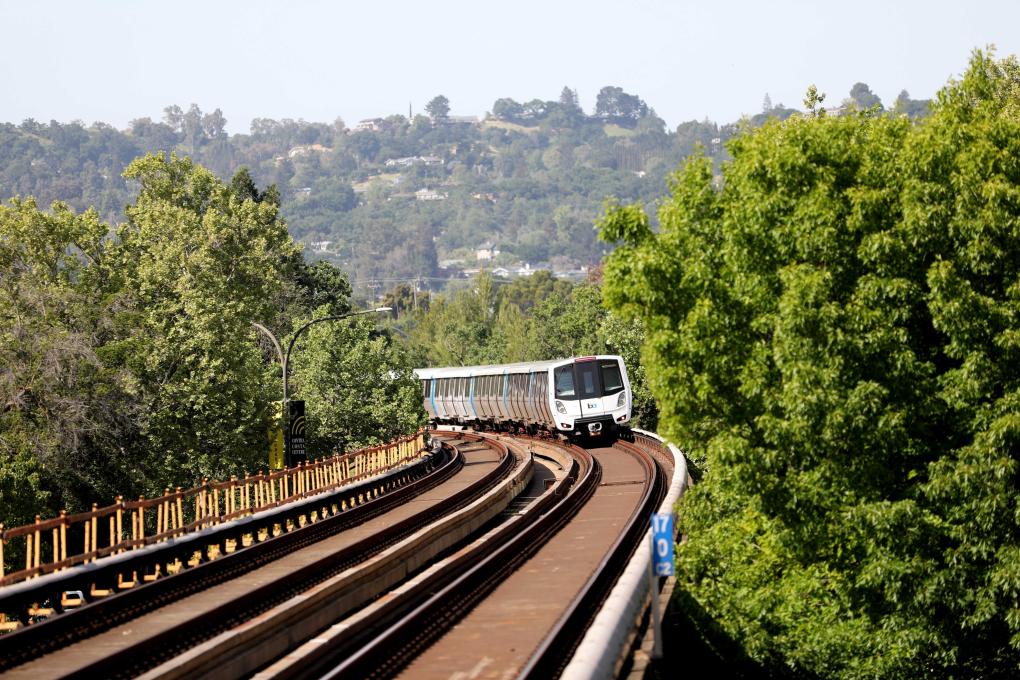
Over the past year, BART has been engaging with our riders and employees via surveys and community meetings to determine our sustainability program priorities over the next decade. We have received your feedback and are excited to share a draft of our new 2026-2035 Sustainability Action Plan (SAP), which will serve as our roadmap for implementing our Sustainability Policy through 2035.
The SAP outlines new goals, metrics, targets, and actions that will define our sustainability efforts, which means using energy and water more efficiently, reducing waste and emissions, improving access to BART stations, and delivering a quality experience for our riders.
The draft of the 2026-2035 SAP will be available for viewing online until October 31, 2026, after which we will make final revisions and publish the completed document in December 2026.
View the draft 2026-2035 Sustainability Action Plan
Please send any comments on the draft to [email protected] by October 31.
Overview of 2026-2035 Sustainability Action Plan
The San Francisco Bay Area Rapid Transit District (BART) is more than a transit system—it’s the backbone of the Bay Area. Every day, it connects people to jobs, schools, healthcare, and each other, linking key destinations across the region, including ferry terminals, airports, and other major transit systems. As the Bay Area grows and changes, BART’s role in supporting a more sustainable, resilient, and just future has never been more important.
The 2026–2035 Sustainability Action Plan (SAP) outlines how BART will continue to support climate resilience, public well-being, and responsible environmental practices through its operations and services. From reducing greenhouse gas emissions and conserving water to expanding access to clean, reliable transit, this plan reflects BART’s commitment to improving quality of life for all who live, work, and travel in the region.
Sustainability covers both environmental and social factors – protecting the environment and the people within those environments go hand in hand. BART aims to create cleaner air, safer stations, and more accessible communities, helping make Bay Area transit essential and transformative.
BART previously published a 2015-2025 SAP, which outlined our sustainability-related initiatives through calendar year 2025. We have taken many of the lessons learned from implementing that plan and applied them to our approach developing this new plan.
BART will publish annual sustainability reports throughout the 2026–2035 SAP to track progress toward its 2030 targets and any interim goals along the way. These reports help ensure transparency, show what’s working, and highlight where course corrections may be needed. As part of this process, BART will update its targets in 2030 to set goals for 2035.
For more information about other aspects of BART’s Sustainability program, please visit bart.gov/sustainability.
Around the Bay this Weekend: Baseball, BART book club, and an art and wine fest
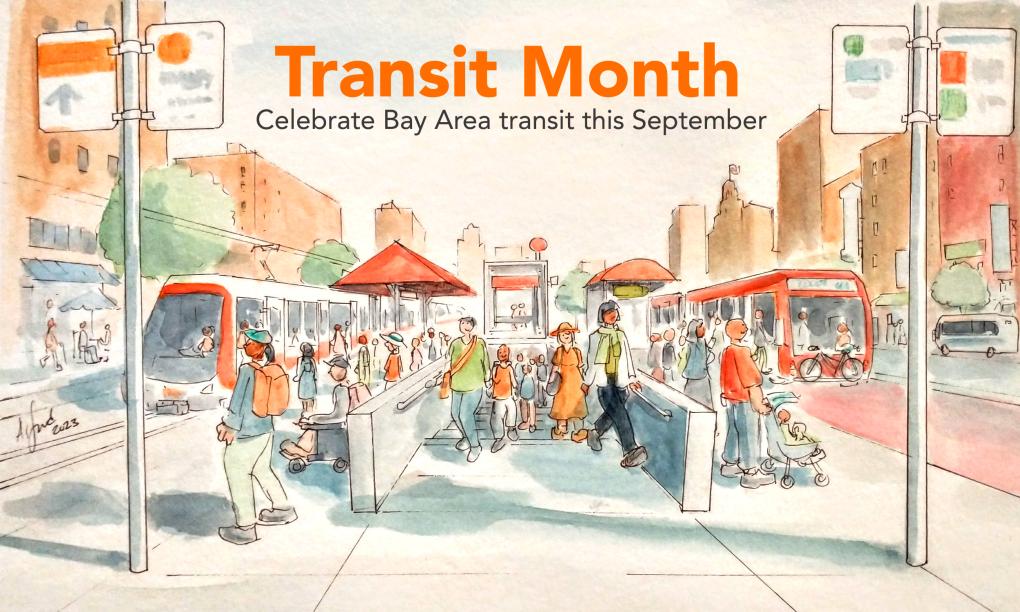
Friday, Sept. 22 – There’s lots do this weekend by way of BART, and we’re here to tell you all about it. Can you believe we're already at the end of September?
Before we get to this weekend's events, we have some exciting news to share. Last weekend, we challenged the region to break the Saturday September 2022 ridership record of 500,000+ trips across all local transit agencies. We are thrilled to announce...we beat the record! On Saturday, Sept. 16, the Bay Area took a stupendous 600,000+ trips. Let's keep the momentum going.
There are lots more Transit Month events on the horizon for the last week of September. On Friday, Sept. 29, join BART’s General Manager Bob Powers along with eight other regional transit leaders for a ride-along and social event. All Aboard with Transit CEOs begins at 5pm at the Palo Alto Caltrain Station/Transit Center. You don’t want to miss it! More info here.
Bus bridge alert: This Saturday and Sunday, Sept. 23 and Sept. 24, there will be hazardous tree removal and track work between Union City and Fremont stations. To provide workers with enough room to safely do the work, free buses will replace trains between Union City and Fremont stations. Riders in the area should anticipate delays of up to 30 minutes. There will be no Green Line service this weekend, meaning trains will not come as frequently as usual and transbay riders will need to transfer. Learn more about the bus bridge here and plan your trip using BART’s Trip Planner.
Now keep reading to hear what’s happening this weekend....
For an in-depth listing of local events, visit the BARTable website. We publish a weekly event roundup, BARTable This Weekend, that highlights happenings around the region as well as cool contests and sweepstakes from our partners.
Friday, Saturday, and Sunday, Sept. 23, 24, 25: Oakland Athletics play the Detroit Tigers at Oakland Coliseum
Baseball season continues with three home games at Oakland Coliseum as the A’s face the Tigers. The Friday game (6:40pm start time) includes an Esteury Ruiz t-shirt giveaway; Saturday (1:07pm) is an MLB Network hat giveaway; and Sunday (1:07pm) is Kids Cheer Free, meaning A's fans ages 14 and under can root for the Green and Gold for free (For each regularly priced ticket purchase, adults can add up to two additional free tickets.)
BART is the best way to get to the game. Read our guide on BARTable.
Saturday and Sunday, Sept. 23 and Sept. 24: 26th Annual Lafayette Art and Wine Festival
This weekend, one of Contra Costa County’s largest festivals takes over downtown Lafayette for a weekend of food, wine, beer, art, and music. The 26th Annual Lafayette Art and Wine Festival runs from 10am to 7pm on Saturday and 10am to 6pm on Sunday. Admission and parking are free, and BART is just a short walk from the fest.
Keep your eyes out for the BART booth, where staff will be on-hand to answer questions and hand out merch.
One Book One BART: BART launches fall ‘23 book club with acclaimed novel by Oakland-based author
On Monday, Sept. 18, BART announced the start of the One Book One BART Fall ‘23 Book Club. The novel strategy for rider and employee engagement follows on the heels of our first book club, which debuted last Spring with Hua Hsu’s Pulitzer-winning Stay True.
This fall – from September 18 to early November – we’ll be reading On the Rooftop (Ecco) by Oakland-based author Margaret Wilkerson Sexton. On the Rooftop is a novel about a mother whose dream of musical stardom for her three daughters collides with their own aspirations, set against a backdrop of a gentrifying 1950s Fillmore District in San Francisco.
We’ve programmed a series of events for employees and the public throughout the fall, including an author talk at our headquarters in Oakland early November and a Train Read-In (think roving book club-style discussions + trivia on a moving train) in October. We hope to see you there!
Stay up to date with events and sign up for the mailing list at bart.gov/bookclub.
Go Shopping, Take BART: Check out vintage and consignment shops near BART stations
There are many hip vintage and consignment shops near our stations. Get on BART and update your autumn wardrobe without having to spend a pretty penny.
Check out BARTable’s roundup of some of our favorite vintage and consignment shops here.
Happy Riding this Weekend!
We hope you enjoy your weekend adventures aboard our trains.
Stay in touch by signing up for the BARTable This Weekend newsletter on the BARTable website – your one-stop shop for all things accessible by BART. You can also keep up with BARTable on Facebook and Instagram.
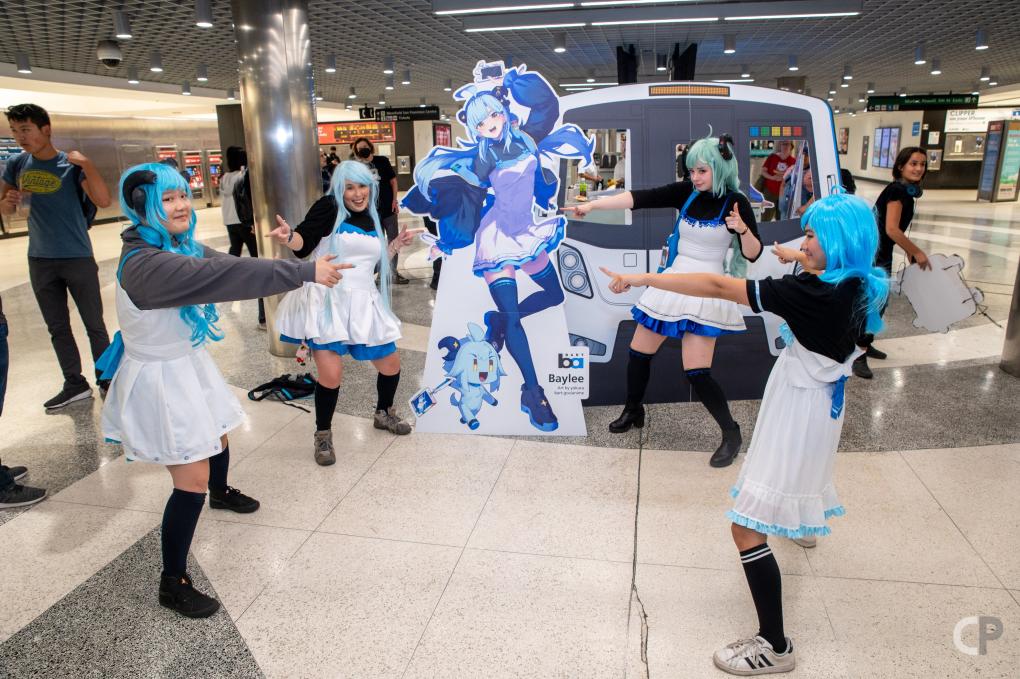
Cosplayers dressed up as BART mascot Baylee pose for a photo during BART’s Meet the BART Anime Mascots event on Saturday, Sept. 16 at Powell St. Station. Photo courtesy of CP Productions.
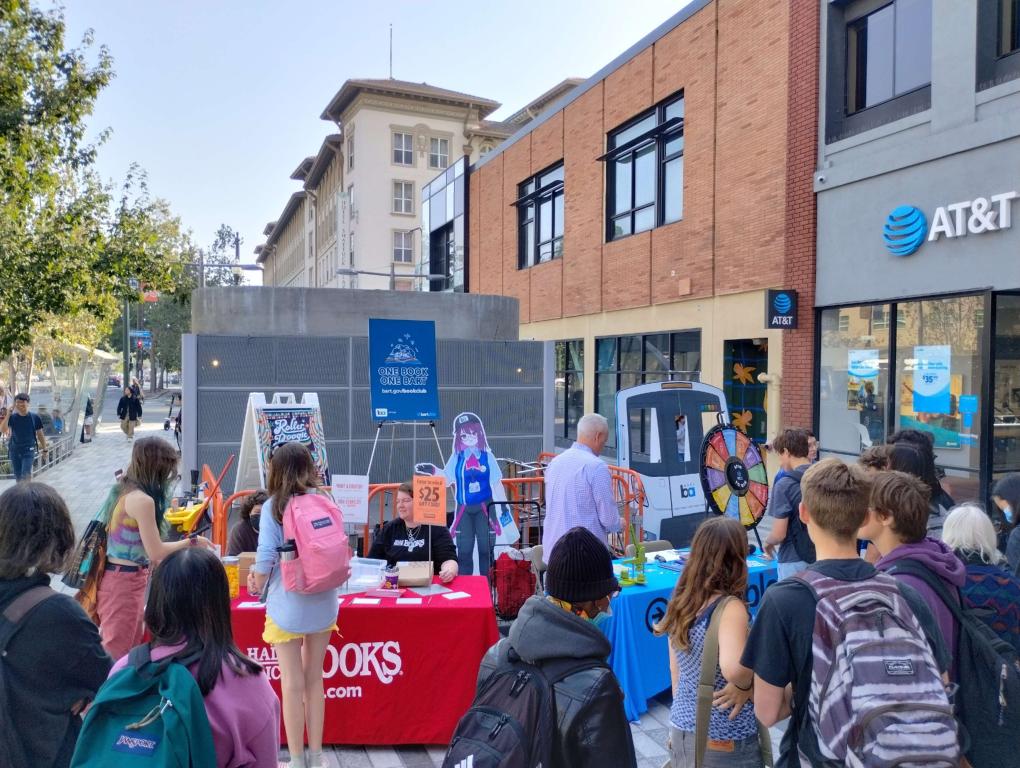
Riders spin the prize wheel, make buttons, and play games with Half Price Books at the One Book One BART Fall ‘23 Book Club kickoff event on Wednesday, Sept. 20, at Downtown Berkeley BART Plaza.
BART Holiday Merch available for preorder or purchase at Railgoods popup shops + SweaterFest

UPDATE: BART Holiday Merch is so popular, we have sold out of our current inventory.
Fear not: You can still purchase all BART holiday merch -- sweaters, vests, beanies, and scarves -- at an upcoming Railgoods holiday popup shop at select BART stations, which will have limited inventory on hand (see dates and locations below). You also have the option to preorder holiday merch on Railgoods.com here (more info below).
Railgoods Holiday Popups:
Wednesday, Nov. 6, 3pm to 6pm, Daly City Station
Wednesday, Nov. 13, 3pm to 6pm, Pleasant Hill Station
Wednesday, Nov. 20, 3pm to 6pm, El Cerrito del Norte Station
Saturday, Dec. 7, 1pm to 4pm, Sweaterfest at Rockridge Station
Thursday, Dec. 12, 3pm to 6pm, Dublin/Pleasanton Station
If you preorder your items on Railgoods.com, at checkout you will have the option to:
Pick up your order at SweaterFest on Saturday, Dec. 7, 1pm-4pm, at Rockridge Station. More info below.
Ship your order for a fee. Items will begin shipping the week of December 9.
Pick up your sweater at BART's Customer Services Center at Lake Merritt Station (hours: M-F 8:30am to 4:45pm). If you select this option, you will receive an email when your order is ready. Orders should be available for pickup the week of December 9.
SweaterFest is back!
Mark your calendars for Saturday, Dec 7, 1pm to 4pm, at Rockridge Station (College Ave. @ Keith). Wear your BART holiday sweater from any year and enjoy crafts, cookies, music, and more. 2024 BART holiday merch will be on sale at the event. There will also be a booth to pickup preordered holiday merch.
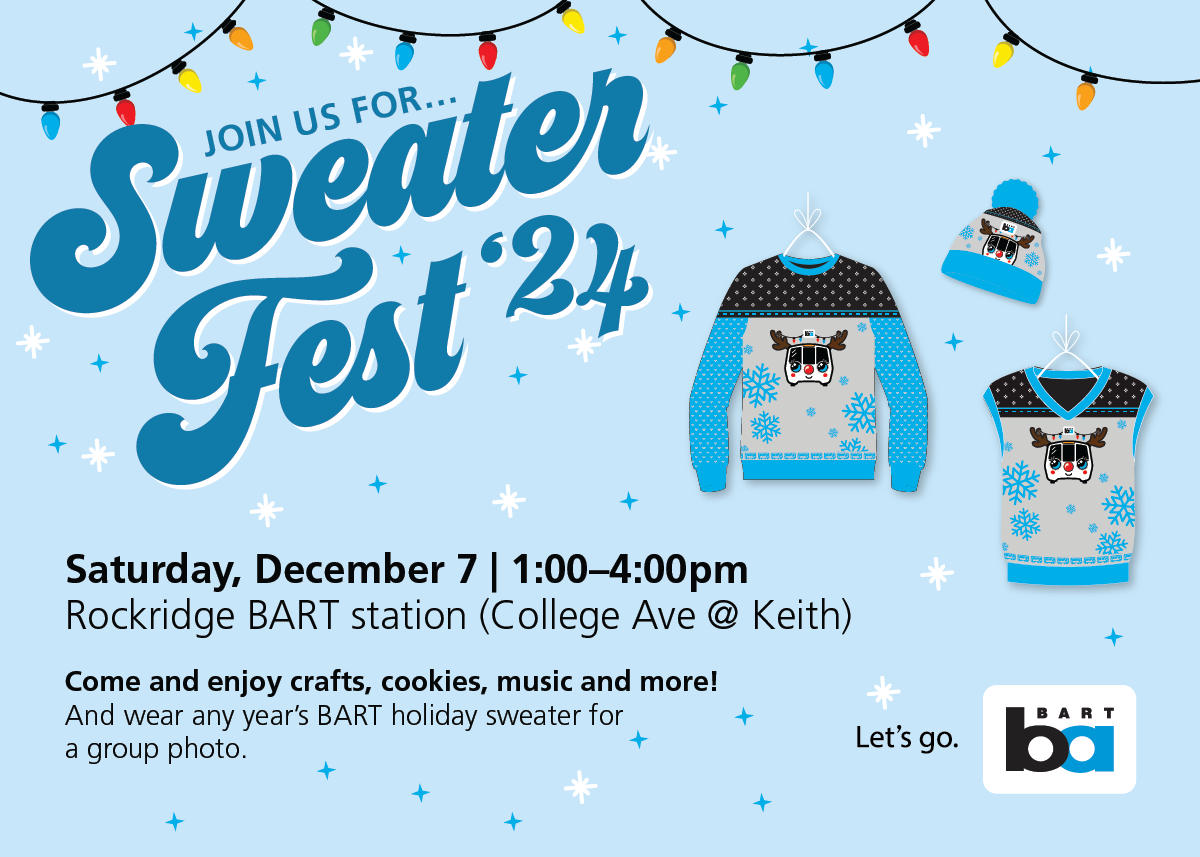
If you preordered a sweater this summer...
If you preordered your holiday merch this summer, your order will arrive shortly. Those who selected the in-store pickup option during the presale should keep an eye out for an alert that their order is ready for pickup.
You can also win holiday merch from BARTable! Sign up for the BARTable This Week newsletter on bart.gov/bartable to enter holiday sweepstakes and to hear about fun holiday events by BART stations.
2024 BART Holiday Merch Prices
Shipping costs vary by weight and location.
Sweater - $49.99 (limit to 2 sweaters per order)
Vest - $39.99
Beanie - $15.99
Scarf - $19.99
BART is at the heart of the Bay Area, and we should be proud of the public institutions that make our region merry and bright. Buy some merch and rep your love for BART and the Bay – the ugly sweater way.
This is the fourth year BART has sold holiday sweaters. Last year, we sold our entire inventory of 3,000 sweaters. Sales exceeded $100,000.
BART is one of the first transit agencies to sell holiday sweaters. We designed the first sweater in 2021 as a BARTable contest giveaway and ordered just five for the contests. Our inventory proved insufficient after General Manager Bob Powers wore one of the sweaters during a media event about BART’s air filters. People wanted them...badly. A week later, we held a sale for the public, and the sweaters sold out in under an hour.
Every year since, despite increasing our inventory into the thousands, the sweaters have sold out.
BART invites small business owners to its 2024 Small Business Summit
BART is pleased to announce it will host its 2024 Small Business Summit event on Monday, April 29th, 2024 on the first floor of its headquarters located at 2150 Webster St. in Oakland.
Attendees will have the opportunity to hear tips from small business owners who have been awarded BART contracts, network with prime contractors, hear about upcoming contracts, learn about BART’s equity program and certifications process and learn about resources available to small businesses from community partners and other regional transit agencies.
BART is committed to ensuring that small businesses are afforded equal opportunities to participate on District contracts and agreements. Small businesses include Disadvantaged Business Enterprises, Disadvantage Veteran Business Enterprises, Minority-Owned Business Enterprises, Women-Owned Business Enterprises and Micro Small Business Entities.
Representatives from several departments and groups at BART will be available at the event to answer questions about upcoming contracts, programs and resources for small businesses. These include representatives from BART’s Infrastructure Delivery and Procurement departments along with staff from BART’s Office of Civil Rights and Small Business Support Services. April 29-May 3 is National Small Business Week. Visit bart.gov/ocr for a list of scheduled events during the week.
Registration is preferred for BART’s 2024 Small Business Summit. Here are event details:
Date: Monday, April 29, 2024
Location: 2150 Webster Street, Oakland CA 94612 (1st floor)
Time: 12:30-3:30 PM
Here is the event schedule:
- 12:30 -1:00 PM: Registration
- 1:00 - 1:30 PM: Opening Remarks
- 1:30 - 2:00 PM: Small Business Success Stories Panel
- 2:00 - 3:30 PM: Networking between BART Staff, Primes, Small Businesses and Public Transit Agencies
Please register at the link here!
